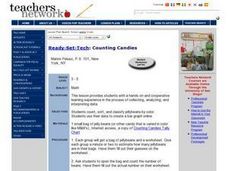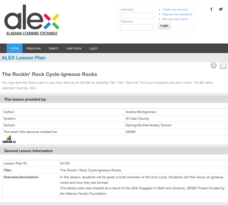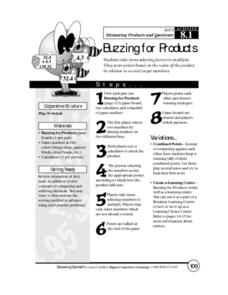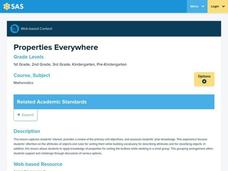Curated OER
Linear Motion
In this fantastic physics and math lesson, student pairs create a ramp that will transport a rolling marble in order to learn about linear motion. Students use cardboard, straws, toothpicks, marshmallows, and paper clips in order to make...
Curated OER
The Slope of a Line
Young scholars define the slope of a line as rate of change. They investigate positive, negative, zero, or undefined slope using a graphing calculator. They determine the slope of a line when given the equation of the line.
Curated OER
Counting Candies
Students count, sort, and classify jellybeans by color. They use their data to create a bar graph. Students are given a small bag of jellybeans, and a worksheet on Counting Candies Tally Chart. They work in small groups. Students are...
Alabama Learning Exchange
The Rockin' Rock Cycle- Igneous Rock
Fifth graders recall prior knowledge about rocks. In this igneous rock lesson, learners work in cooperative groups to perform experiments to classify the properties of igneous rock. They write a detailed paragraph and illustrate the rock...
Curated OER
What's The Scoop?
Students explore the properties of matter. In this cross curriculum three states of matter science instructional activity, students listen to the poem "Eighteen Flavors" by Shel Silverstein, and predict what will happen if listed...
Curated OER
Apple Estimation: Percentages & Subjective Reasoning
Students practice using their estimation skills by utilizing apples. In this percentage lesson, students utilize a scale and an apple to discover the percentage of each bite they take. Students share their data with the rest...
Curated OER
Buzzing for Products
Students practice multiplication playing a game. In this multiplication lesson plan, students pick numbers and multiply them together. Students are awarded points based on which "hive" their answer falls in. The student with the...
Curated OER
Simplify Expression Using the Order of Operations
Allow learners to explore both the right and wrong way of completing equations with the order of operations. They discuss how the order in which operations are performed affects the outcome of a problem. A fun "trick" using order of...
Curated OER
Integer Addition
Seventh graders explore the concept of integer addition. In this integer addition lesson, 7th graders tell stories involving addition and subtraction. Students walk on a number line given directions such as add 3 or add -2. Students play...
Curated OER
Equivalent Equations
Answer the age-old question every middle schooler has, what are equivalent equations? Here, they will explore the concept, discuss what equivalent equations are, and how to solve them. They also discuss performing an operation on both...
Curated OER
Decimal War
Students practice decimals by playing war. For this decimal lesson plan, students flip over their cards and whoever's card is higher wins those cards. The person with the most cards is the winner.
Curated OER
Algebra/Geometry Institute: Area of Polygons
Students find the area of polygons. In this area of polygons lesson, students find the area of parallelograms, rectangles, squares, and other polygons. They identify each given figure and determine the appropriate formula...
Curated OER
Reading, Writing, And Math in Daily Living
Students, in groups, make chocolate chip cookies following a recipe.
Curated OER
Multiple Intelligences Holistic Plan
Ninth graders apply basic algebra concepts to equations using cognitive, affective, and kinesthetic components. They create their own word problem, perform the story problem using a dramatic presentation, and present the problem to the...
Pennsylvania Department of Education
Properties Everywhere
Students examine and sort objects by specific attributes and apply prior knowledge. In this properties everywhere activity, students work in groups to arrange objects in categories then discuss various sorting options while...
Curated OER
Pedal Triangles
Pupils identify the properties and theorems of triangles. In this geometry lesson, students construct angle bisectors using a compass and straight edge. They identify triangular similarity and congruency.
Curated OER
Menelaus' Theorem
Students investigate Menelaus Theorem. In this geometry lesson, students calculate the area of polygons. They differentiate between boundaries point, interior points and area of lattice points.
Curated OER
Ceva’s Theorem
Students prove and use Ceva's Theorem to solve problems. In this geometry instructional activity, students analyze polygons for patterns and calculate the area of each shape. They relate polygons to the real world.
Project SMART
Exploring the History of Mathematics
Students research six different mathematicians using Internet resources. They examine the contributions of different cultures, women, and one that made a significant to geometry. They present their research to the class.
Curated OER
Place Value for Whole Numbers
Fourth graders, in groups, explore place value for whole numbers. They explore how to use base-ten materials to make sense of place value in the tens and ones column. They also explore whole-number patterns by using base-ten materials.
Curated OER
Discovering Euler's Theorem
Students identify different parts of a prism and polyhedra. In this geometry lesson, students identify the number of faces, edges and sides of polygons. They solve problems by recognizing patterns.
Curated OER
Spring Potted Plants
Students identify and interpret plant growth as well as gain graphing skills and other important knowledge related to potting plants. They take a regular milk jug and cut off the top, leaving the handle and the rest intact. Then,...
Curated OER
Take Two and Call Me in the Morning
Eighth graders are introduced to the workings of the major systems of the Human Body: circulatory, digestive, respiratory, nervous, skeletal, and endocrine Systems. They learn the major organs of the systems and their functions.
Curated OER
Finite Geometry
Students solve for the area and perimeter of polygons. For this geometry lesson, students identify repeated patterns and create formula to solve problems. They make conjectures and prove hypotheses.























